April - June 2007 - Kasetsart University
April - June 2007 - Kasetsart University
April - June 2007 - Kasetsart University
Create successful ePaper yourself
Turn your PDF publications into a flip-book with our unique Google optimized e-Paper software.
290<br />
natural mineral soils, the soil samples were<br />
collected from different sites of Somali region and<br />
from Zeway area of East Showa zone, Oromiya<br />
Regional State. The sites in Somali region were<br />
selected from Jijiga and Shinile zones based on<br />
the suggestion of Somali Regional Pastoral and<br />
Agro Pastoral Research Institute (SoRPARI) and<br />
the clan leaders. Soil samples were collected from<br />
the sites (Arabi, Jair, Hermokale and Bole) where<br />
pastoralists mostly use for mineral supplementation<br />
to their animals. Individual natural mineral<br />
soil was collected using hoe to the depth of 30 cm<br />
from three different spots which fall in the radius<br />
of 50 to 70 m. Soil samples were mixed together<br />
and then filled into a plastic collection bag, labeled<br />
and stored at room temperature. A total of four<br />
composite soil samples from the study sites were<br />
taken and analyzed for physical and chemical<br />
properties at National Soil Laboratory for Research<br />
Center (NSLRC). Analysis of each sample was run<br />
in duplicate.<br />
The pH and electrical conductivity of the<br />
soils were measured according to the procedure<br />
of Landon (1984). Ca, Mg, Fe, Mn, Zn, and Cu<br />
were determined by atomic absorption<br />
spectrophotometer (Lindsay and Norvell, 1978).<br />
Sodium and potassium were analysed by flame<br />
photometer (Black, 1965). Organic carbon was<br />
determined following the wet digestion method<br />
of Walkley and Black (1934). Available<br />
phosphorus was determined following Olsen<br />
methods (Olsen et al., 1954). Total nitrogen was<br />
determined using the modified Kjeldahl method<br />
(Jakson, 1958).<br />
Liver tissue collection and analysis<br />
A total of sixteen sheep (two sheep from<br />
each treatment group) were randomly selected and<br />
slaughtered to determine liver mineral contents.<br />
Liver tissue samples of 50 to 100 g were taken<br />
from the right lobule of liver of individual animal.<br />
The samples were stored frozen until analysed for<br />
Ca, Mg, Fe, Mn, Cu, Zn and Co using flame atomic<br />
<strong>Kasetsart</strong> J. (Nat. Sci.) 41(2)<br />
absorption spectrophotometer (Perkins-Elmer,<br />
Model 2380).<br />
Statistical analysis<br />
Data were analyzed using the PROC<br />
ANOVA procedure of SAS (1999). Differences<br />
among treatment means were evaluated using<br />
Duncan Multiple Range Test (Cody and Smith,<br />
1997). The statistical model used was:<br />
yij = µ+ Ti + εij<br />
Where, Yij = Response variable (body<br />
weight gain, mineral intake and mineral in liver<br />
tissue)<br />
µ = Overall mean<br />
Ti = The effect of ith treatment<br />
(i = 1, 2, 3, 4, 5, 6)<br />
εij = Residual effect<br />
RESULTS AND DISCUSSION<br />
Physical properties of the mineral soils<br />
Most naturally occurring mineral<br />
deficiencies in livestock are associated with<br />
specific regions, and they are related to both soil<br />
mineral concentration and soil characteristics<br />
(McDowell 1986). Physical properties of mineral<br />
soils collected from different sites are presented<br />
in Table 1. pH of the soil samples ranged from 8.0<br />
for soils from Arabi to 9.5 for soils from Bole sites<br />
indicating that they were alkaline in nature. The<br />
pH values soils was higher than the pH values<br />
(ranged from 7.86 to 8.05) of natural mineral soil<br />
from Southern low lands of Ethiopia (Kabaija and<br />
Little, 1987; Fikre, 1990). Colours of the soils<br />
varied from site to site ranging from dark brown<br />
to light brownish colours. The soil textures varied<br />
from silt to loam. The soils in Jair and Hermokale<br />
areas were predominantly silt loam but Arabi soil<br />
were silt in texture whereas Bole soils were sandy<br />
clay. The color and texture of individual natural<br />
soils are as shown in Figure 1.
















